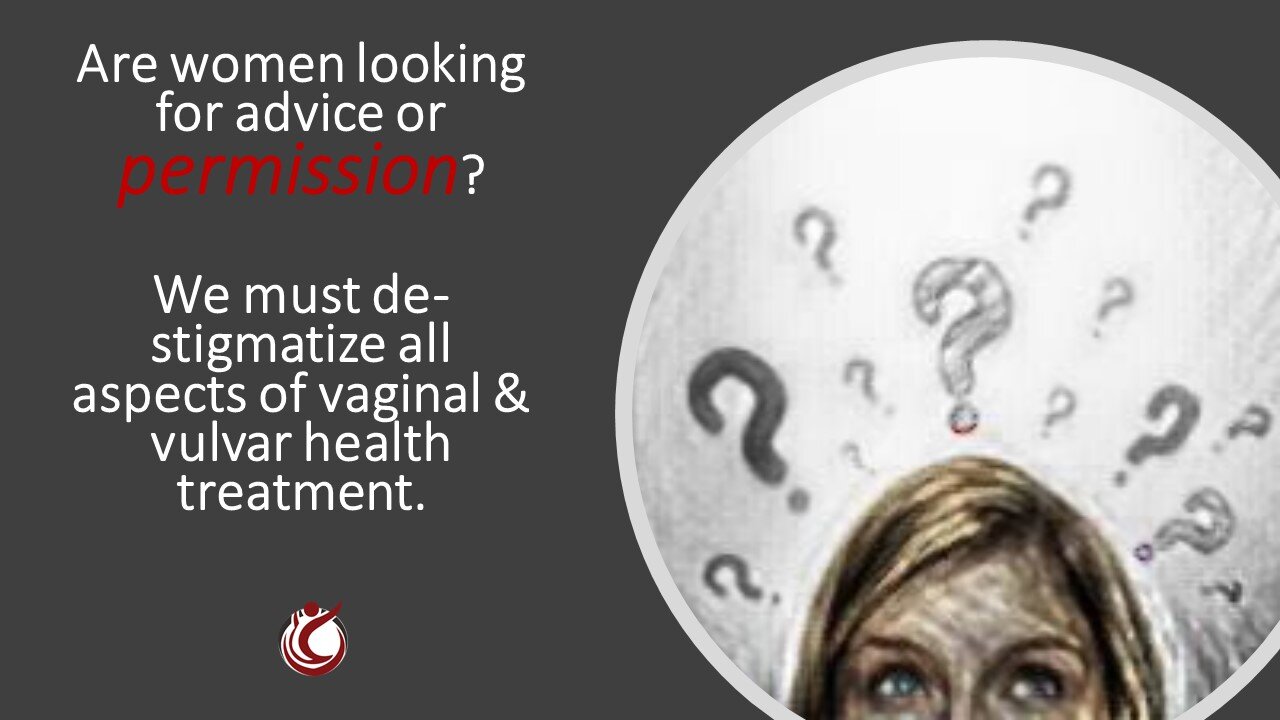We Must Overcome the Culture of Silence in Vaginal and Intimate Health
Vaginal health is of notable significance regarding women’s sense of sexual wellness, but is a seldom openly acknowledged or discussed aspect of women’s health. Females typically put their health needs last, whether they are CEOs of large corporate entities, clerks at Walmart, stay-at-home moms, or deeply embedded in medical practice.
Vaginal laxity is an overlooked, often cryptic aspect of health many women find bothersome. Why can’t women bring themselves to talk out loud about vaginal laxity or the “gap”, that gaping vaginal opening and stretched out internal tube of vaginal space that typically occurs after vaginal birth? Vaginal laxity impacts sexual sensation, and women not only have less than satisfying sexual encounters, they also worry whether their partners are. The gap impacts women’s self-esteem in ways that seldom make it into sexual conversation with intimate partners. Discussions seldom occur during pelvic exams. Women worry that their vulva is unattractive and may be a turn-off for their intimate partners.
Both patient and practitioner opinions are imperative to provide balance to this most pivotal conversation about women’s health and sexuality. To lift the shroud of secrecy, let’s dive a bit deeper into this aspect of vaginal heath. Kicking off the conversation is an empowered woman in her 30’s. Melissa explored options to treat pelvic organ prolapse and simultaneously address vaginal laxity and gap concerns. Adding balance to the discussion is cosmetic gynecologist/urogynecologist Marco Pelosi III MD.
***
Melissa’s share:
Please share your POP history; age of pelvic organ prolapse onset, age of diagnosis, the cause of your POP.
I suspect I had a very mild rectocele after giving birth vaginally the 1st time, at 29. Never diagnosed, but I did sometimes need to splint to have a bowel movement. I was diagnosed with retroverted uterus when I was pregnant with my 2nd child at the age of 31. After giving birth vaginally the 2nd time at the age of 32, I was diagnosed with rectocele. Childbirth was the cause, although I used to do some heavy lifting as a Pre-K child educator which I had to give up once I was diagnosed.
Did you self-diagnose, or was your POP diagnosed by your OB/Gyn?
I was diagnosed by my OB/Gyn when I went in 10 days post-partum due to severe constipation.
What type(s) of POP did you have?
I was diagnosed with rectocele. I later found out there was an enterocele too, and slight bladder and uterus prolapse as well.
Were you familiar with pelvic organ prolapse prior to your diagnosis?
I researched POP when I was first having to splint to have a bowel movement after giving birth to my first child. I had never heard of it before that.
What treatments had you tried to treat your POP?
I tried physical therapy and found it unhelpful and painful.
I then had surgery at 3 months postpartum for the rectocele. When they went in, they wound up having to fix the enterocele instead. I read this in my notes a year later, was never told they changed the procedure. I saw no improvement in symptoms (constipation, urine leakage, painful sex).
I tried an OTC pelvic muscle exercise device, but found it only helped with urine leakage, not prolapse.
I tried a pessary, but it was painful (caused severe rectal pressure) and I was unable to have a bowel movement at all with the pessary in. It pinched off the path.
Then I used a sea sponge as a pessary. It was more comfortable, but it got stuck in position and I had to have it removed by a gynecologist, who told me it was not a good idea to put sponges in your vagina. She suggested a mesh bladder sling, which I did not want.
I tried multiple pharmaceutical medications for incontinence and constipation.
I tried vaginal estrogen.
I finally had my 2nd surgery 18 months postpartum.
What repairs were included in your surgery?
My first surgery at 32 included native tissue enterocele repair (instead of the planned rectocele repair). My second surgery at 34 included an abdominal laparoscopic non-mesh bladder lift, hysteropexy uterine suspension, vaginal rectocele repair, perineum repair, labiaplasty (labia was partially torn off during childbirth and needed to be reattached), and vaginoplasty.
Did you consult a urogynecologist, and if so, at what point?
I saw a urogynecologist who was also a cosmetic gynecologist at 18 months postpartum. I traveled 5 hours to Atlanta to see him. I sought treatment from a local aesthetics surgeon first who only offered laser vaginal rejuvenation, and to his credit, admitted it does not provide a permanent fix for prolapse. He also told me he could only remove my labia, not re-attach it.
Was intent of vaginoplasty to repair POP or to address the gap and improve your sensation & intimate relations?
The vaginoplasty portion of the procedure was to improve sexual function. The other procedures I had along with it addressed the prolapses. The bladder lift, hysteropexy, and other repairs were covered by insurance. The labia re-attachment and vaginoplasty were not.
How did the process of consult go for vaginoplasty?
When I arrived at check in, they gave me a small slip of paper, and asked me to please answer this question: "Are you interested in a vaginal tightening procedure?" I checked yes. I saw the doctor, he stated I had multiple prolapses, and he was surprised I'd already had a repair, he said it didn't look like they'd fixed anything. I got dressed and met him in his consult room with my husband. He described all the procedures to fix the prolapses, and I said okay to all of those. He then sent in a female office employee to discuss the vaginoplasty, she basically said it would be $6000 out of pocket and gave us a credit application. My application was approved, and they added the vaginoplasty to the procedures. I asked about labiaplasty at this time, and that was also added to my list of procedures.
How long was your heal curve with the multiple procedures?
It took me 14 weeks to heal enough to go to work. It took 8 months to heal enough to have intercourse.
How painful was the heal curve?
It was virtually painless because I was fortunate enough to be able to take time off work and just lay down a lot. I was also on opioid pain medication for 3 weeks.
Did you allow your husband to voice an opinion about whether you should have procedure or not, or was it your decision solely?
My husband realized I wanted the procedure badly, and he supported it for that reason. He never pressured me to have it. It cost a lot of money, and I was hesitant to spend that much, but he was vocally in favor of the repairs so I felt okay about doing it. Sex was too painful for me in the two years between my 2nd birth and my procedure, so we weren't having any at all. We really had nothing to lose and everything to gain.
Are there any questions you wish you had asked your surgeon?
I don't really have any questions I wish I'd asked because he was so prepared and told me everything I needed to know before my repairs. I do wish I'd asked my first doctor more questions, as maybe if I'd known he couldn't do anything to fix a rectocele or restore sexual function I would have skipped that operation and only had surgery once.
Insights from Marco Pelosi III MD:
When a woman consults with a cosmetic-gynecologist with complaints of lack of sexual sensation because her vagina is too loose, does the physician assess introitus, vaginal canal, or both?
A properly trained cosmetic gynecologist would check all of these areas. However, in my world, a qualified cosmetic gynecologist is also really good at urogynecology. The never-ending problem though is that there are many pretenders who call themselves cosmetic gynecologists and know zero about urogynecology, and vice versa.
Does the size of the “gap” at the introitus indicate the width of the entire vaginal canal, or just the entrance size?
The vagina is shaped like a funnel. The introitus is the mouth of the funnel. I measure the dimensions at the introitus and at the mid-vagina levator region separately. They represent different muscle groups.
Can vaginal laxity or wide vaginal gap at the introitus contribute to less support of pelvic organs, thus impacting pelvic organ prolapse degree of severity?
Absolutely. The question you are asking is "What is the function of the perineum?" The perineum is that last structure between the pelvic organs and the outside world. And if that structure is broken, your pelvic organs are headed on an unplanned trip to the outside world.
Please describe how cosmetic repairs to address vaginal laxity or wide introitus differ from a traditional a&p (anterior/posterior prolapse) repair.
Cosmetic repairs are focused on reducing caliber at the level of the muscles. Traditional repairs are focused on lifting vaginal supports at the level of the fascia. They don't address muscles or caliber in any meaningful way.
If a woman has levator damage from childbirth, and has vaginal laxity as well, would addressing laxity provide support to the organs?
What you are asking in essence is does a levatorplasty provide pelvic floor support? It does do a degree, but not enough. This would be tantamount to skipping a rectocele repair and substituting a muscle repair instead. This was tried for over a half century with aggressive muscle repairs and the result was severe pain and high failure rates. Here is more information to clarify.
https://www.iscgmedia.com/iscg-blog/theyre-wrong-about-levatorplasty
Do you feel vaginal laxity will ever be considered an essential insurance covered procedure (vaginal hyperlaxity syndrome?) if this repair provides support for the pelvic organs?
When lousy sex is considered a medical problem and when surgery for lousy sex is considered a medically indicated treatment for its management (pigs will be flying at this point), then perhaps medical insurance companies might cover this. However, since the correction of vaginal laxity doesn't support the pelvic organs, that would never be a basis for getting it covered.
***
Why are vaginal and intimate health shrouded in silence? Why does the world at large continue to find it awkward to talk about these pivotal aspects of women’s health out loud? When we overcome this last significant barrier in female empowerment, women's health will finally be set free.
#APOPS #EveryVoiceMatters


